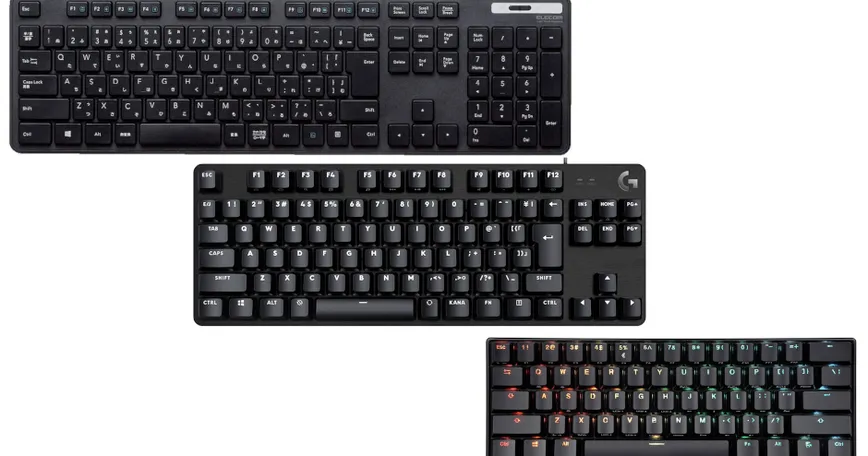
Advantages and disadvantages of different PC keyboard sizes
PC keyboards come in a variety of sizes, each with its own features, advantages and disadvantages. In this issue, we will introduce them all together and compare their merits and demerits.
Modified at: 2023.2.9Posted at: 2022.8.11
Main PC keyboard sizes
PC keyboards come in three main sizes
- full size
- ten-keyless size
- compact
Each has different features, advantages and disadvantages, so it is best to use them for different purposes.
Advantages and disadvantages of a full-size keyboard
This is the largest keyboard size, with the main alphabetical keys, arrow and other operation keys, and a numeric keypad. Most standard keyboards that come with desktop PCs are this size.
Because there are so many keys, a variety of operations can be performed with the keys. Users who make heavy use of the numeric keypad and function keys in particular are likely to be fans of full-size keyboards.
The disadvantage is that there are many keys on the right side from the center position, so the mouse is laid out largely on the right side from the center position.
This is fine if keystrokes are the main input, but if you often work with a mouse at the same time, it can lead to shoulder and back fatigue.
Advantages and disadvantages of tenkeyless size keyboard
A tenkeyless keyboard is a full-size keyboard minus the numeric keypad. Some models omit the function row as well as the numeric keypad.
This keyboard size has been gaining popularity over the past few years because it is smaller and sleeker than a full-size keyboard, but still offers the same typing feel as a full-size keyboard for general use.
Another advantage is that the absence of a numeric keypad section allows the mouse to be operated in a position close to the center position.
The disadvantage is that it is a halfway point: smaller than a full-size keyboard, but not as space-saving as a compact keyboard.
Advantages and disadvantages of compact
A compact keyboard is the size of a full-size keyboard minus the numeric keypad, faction lines, arrow keys, etc., leaving only the main alphabetical part. Depending on the number of keys, it is called 65% keyboard, 60% keyboard, and so on.
The advantage of a compact keyboard is space saving. While being the same size as a notebook keyboard, the compact keyboard can be used with mechanical keyboards and other professional keyboards designed for desktop use, making it popular mainly among notebook PC users.
Another advantage is that the narrow width of the keyboard allows the mouse to be laid out in a fairly natural location relative to the center position, saving space and placing less strain on the body.
The disadvantage is the small number of keys. The Fn key assignments also vary from product to product, so typing tends to develop its own habits.
Once you become accustomed to the shifting typing speed of compact keyboards, the habit is so strong that when you switch to other keyboards, you will make a series of typing errors, so you need to adapt your keyboard when using it in multiple environments.
Compare the features, advantages and disadvantages of each size
Finally, let's compare the features, advantages and disadvantages of each size.
| full size | tenkeyless | compact | |
|---|---|---|---|
| size | large | slightly large | small |
| Occupy desk space | Wide | Slightly | Space Saving |
| key layout | general | generic | generic |
| mouse position | very right | slightly right | immediately right |
| Advantages | More keys | Lack of numeric keypad only Better balance between size and usability | Space saving |
| Disadvantages | Width eating Lack of flexibility of layout | In some ways half-baked | Some keys are special Weird typing habits develop. |
It is clear that every size has its own advantages and disadvantages, and there is no perfect size.
Depending on the desk size, the environment in which it is used, and the scene in which it is used, each characteristic can be both an advantage and a disadvantage.